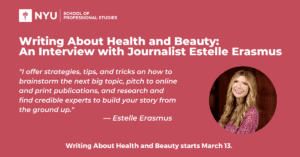Health and beauty is an expanding genre of writing that editors are hungry for. How do you craft a compelling service journalism piece, personal essay, or reported feature on this topic? In Estelle Erasmus’ course Writing About Health and Beauty, you can learn the ins and outs of finding your story, reporting, and pitching on this subject. Erasmus is an award-winning journalist and writing coach who has published extensively in this genre. Read on below for our Q&A with Erasmus to learn more about the eight-week course!
What can students expect from the Writing about Health and Beauty course?
EE: Health and beauty writing is a growing area in publishing, covering a wide range of topics from chronic illness, mental health, and preventative strategies to beauty routines and new therapies and products. In this eight-week course, I offer strategies, tips, and tricks on how to brainstorm the next big topic, pitch to online and print publications, and research and find credible experts to build your story from the ground up. I will work directly with students on pitches, essays and articles, and brainstorm topics. During the course, you will receive recorded video interviews from editors who cover health with insight and advice on submitting, and new interviews are added each semester. Students will also have the opportunity to interview and build connections with working experts in the health and beauty field. Students will leave class with one service piece, ready-to-publish personal essay, or hybrid essay/reported piece on health or beauty. Previous participants have published articles and essays generated in class in The New York Times, The Washington Post, Next Avenue, Chicken Soup for the Soul, The Daily News, Wired, GH, and more. I always say editors are in the field searching for writers with good stories. Why not let that writer be you?
How would you define this genre of writing? What does it encompass?
EE: This is such a wide-reaching genre of writing. It encompasses psychology, self-esteem, mental health, physical, emotional, medical, and even spiritual health issues, as well as specific diseases, chronic issues, alternative and covering every beauty and health remedy available, including cosmetic surgery, from a service-oriented, reported journalistic or anecdotal perspective.
My focus is mainly on health writing because it is a burgeoning field for writing opportunities, including in the parenting and aging space, but many times the editors who cover beauty also cover health, so it is very much a linked subject.
Why do you think writing about health and beauty is compelling?
EE: Because everyone is interested in maintaining optimum health, and let’s face it we are a society where packaging is important and remaining healthy showing our best selves in the area of visual mediums like television, TikTok and Instagram only helps us advance in our careers.
Also, when publications make staff and space cuts, it seems that one safe area is the health space, because with a growing older population, health is on the frontline of every person’s thoughts.
How has this genre shaped your career as a journalist and storyteller?
EE: I started my career in publishing as Associate Beauty Editor, writing about health and beauty for Woman’s World magazine, and co-authored a beauty book with a dermatologist. I went on to cover fitness, mind/body therapies as a columnist and contributor for First for Women, a columnist for New Body, and Let’s Live, and have contributed health and beauty articles to over 100 publications. I also launched the American Breast Cancer Guide for women with or at high risk for breast cancer, and I launched a magazine that covered health and cosmetic surgery. Once I had my daughter, I also covered health and mental health from a parenting perspective for GH, Parents.com, The Washington Post, The New York Times, and more. I loved telling stories about people in the health space, experts, and anecdotal, too, and enjoy teaching my students how to approach those kinds of stories, as well, and cover more in the Freelance Writing Direct podcast and in my book WRITING THAT GETS NOTICED: Find Your Voice, Become a Better Storyteller, Get Published, out from New World Library in June, available now for pre-order. And sign up for my newsletter to get publishing advice and opportunities.
What do you find most rewarding about teaching this course?
EE: The journalism skills I teach in this course are complementary to any other journalism program or master’s program at NYU or another university. I enjoy continually evolving my classes, and many of my students take my courses over and over. I have changed the syllabus to encompass more service journalism, interviewing experts (with actual experts available for interviews), new editor interviews in the space — since editors change positions often.
I’ve focused on increasing the engagement in my online forums, not just between myself and the students (which has always been active), but between the students themselves. Many of my students have stayed connected and even formed writing groups out of the comradery they’ve found in my classes.
Also I have a free Editor-on-Call webinar in collaboration with NYU on March 2 from 12:30-1:30 pm EDT in conversation with Julia Calderone, Senior, Editor Well for the New York Times (who covers health and science). This is the link to get your spot. I hope to see many of you there and in my class.
Sign up for Writing About Health and Beauty, starting March 13.
